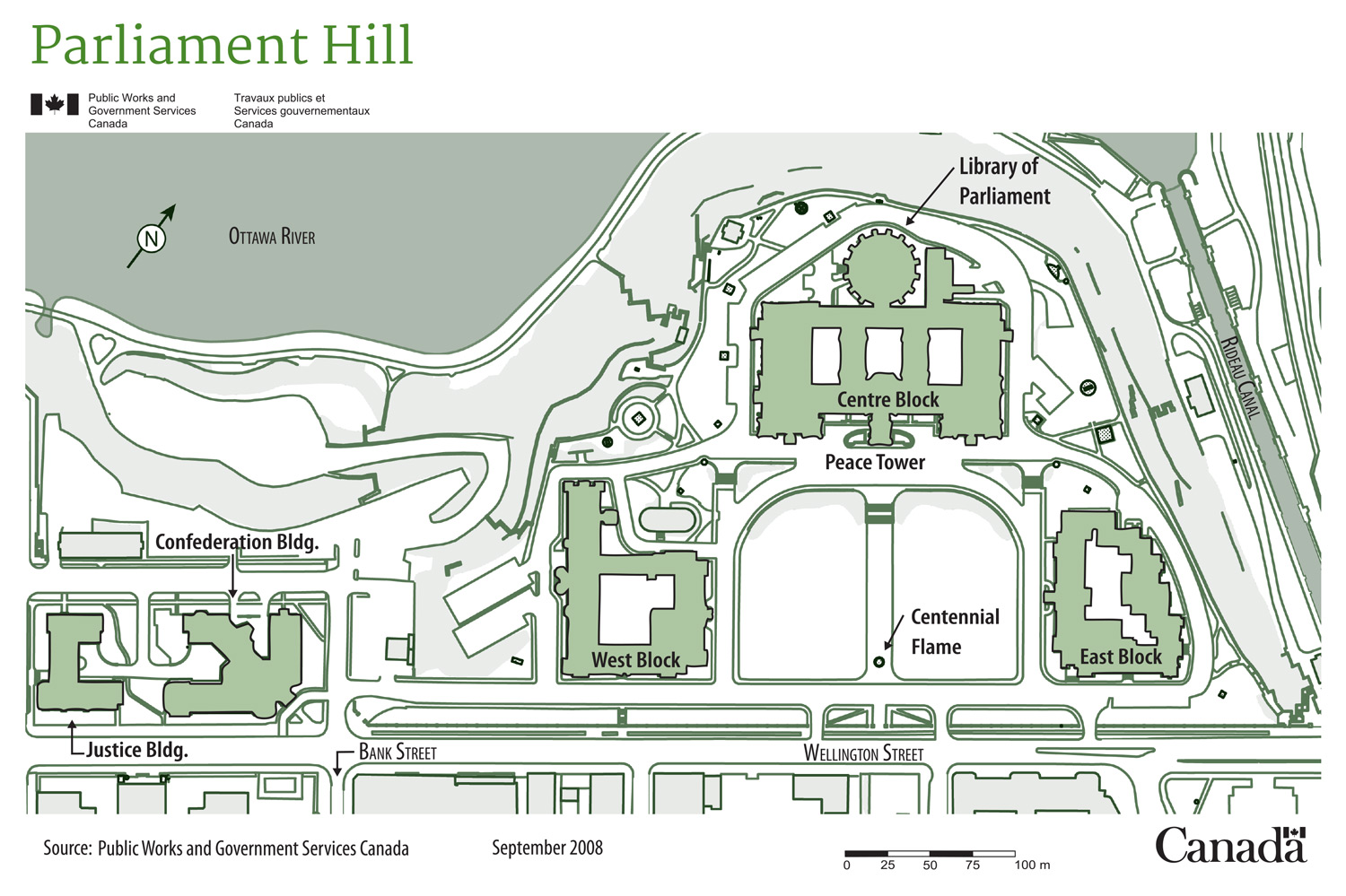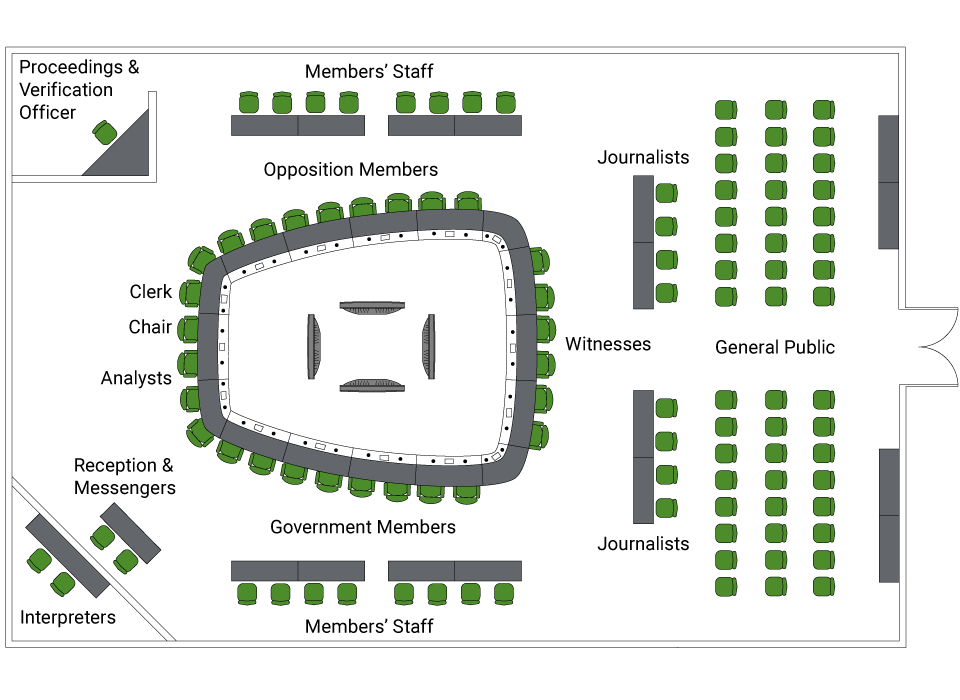Physical Setting
Summary
The House of Commons operates within a distinctive physical and administrative setting on Parliament Hill in Ottawa. The parliamentary precinct includes both the Senate and House of Commons and is managed under the joint authority of their respective Speakers.
The Chamber, temporarily relocated in the West Block courtyard, is the focal point of legislative activity. It features tiered seating divided by a central aisle and a Speaker’s chair. The ceremonial mace and dedicated spaces for government and opposition members reflect parliamentary traditions. Adjacent lobbies provide private spaces for members of Parliament during sittings, while galleries accommodate guests and the public.
Committee rooms facilitate proceedings, equipped with modern technology for recording and remote participation. Interpreters, verification officers, and pages support operations in the Chamber and in committees.
Introduction
The House of Commons conducts its business in its own unique physical setting and under administrative structures of its own making. These two factors are an important backdrop to the operations of the House. This article provides information about the Parliament Buildings, the House of Commons Chamber and the committee rooms.
The Parliament Buildings and Grounds
The area known as Parliament Hill is situated on a cliff, on a site overlooking the Ottawa River in downtown Ottawa. The parliamentary precinct—the premises occupied by the Senate and the House of Commons—includes buildings both on Parliament Hill and in its immediate vicinity.

Given Parliament’s exclusive right to administer its own internal affairs, the Speakers of both Houses have traditionally held authority and control over accommodation and services within the parliamentary precinct. At Confederation, Parliament Hill was transferred from the imperial government to Canada. As such, control of the grounds and construction, repair and maintenance of the buildings falls under the general mandate of a government department, Public Services and Procurement Canada, which is responsible for federal buildings and properties.
Long Term Vision and Plan for the Parliamentary Precinct
As custodians of the Parliament buildings, Public Services and Procurement Canada works closely with its parliamentary partners—the Senate, the House of Commons and the Library of Parliament—to develop and implement the Long Term Vision and Plan, a master plan for improvements to the parliamentary precinct spanning over 25 to 30 years. As the plan is carried out, several buildings in or near the parliamentary precinct are temporarily repurposed to provide interim accommodation for core parliamentary and support functions, with the most significant interim accommodation being the temporary House of Commons chamber in the West Block courtyard and the temporary Senate chamber in the Senate of Canada Building (formerly known as the Government Conference Centre).
The House of Commons Chamber
Each day when the House meets to conduct business, the Speaker’s Parade leaves the Speaker’s office and passes through the corridors in West Block, through the foyer at the end of the chamber opposite the Speaker’s Chair, and into the chamber itself. Members gather in the physical or virtual chamber to participate in the proceedings, and each sitting is supported by personnel from the House of Commons Administration. Select the tile below for a 360-degree virtual tour of the House of Commons chamber, located in what was previously the courtyard of the West Block.
Virtual Tour of the HouseThe Seating
The chamber is divided by a wide central aisle and is furnished on either side with tiered rows of desks and chairs, facing into the centre. All members of Parliament have their own assigned seat in the chamber. While the allocation of seats is the responsibility of the Speaker, it is carried out in collaboration with the party whips.
Members of the governing party are seated to the Speaker’s right, with the Prime Minister and members of cabinet sitting in the front rows. When there are more government members than can be accommodated on the Speaker’s right, some are seated on the left, usually in the seats closest to the Speaker.
Opposition members are seated to the Speaker’s left, with the Leader of the Opposition sitting directly across the floor from the Prime Minister, flanked by members of his or her party. Traditionally, the front-row seats to the left of the Speaker are reserved for leading members of the opposition parties. When there are more opposition members than can be accommodated on the Speaker’s left, the remaining opposition members are seated on the right, closer to the end of the chamber opposite the Speaker’s chair. Members of parties not recognized in the House and independent members are assigned seats by the Speaker.
Members participating remotely and speaking appear on two giant screens located on either side of the Speaker's chair.
The Speaker’s Chair
The Speaker’s chair stands on a dais at the south end of the chamber. From this chair, the Speaker is responsible for presiding over debate and the preservation of order and decorum during House proceedings by interpreting and enforcing the rules and practices that members of the House have adopted.
The Table
In front of the Speaker’s dais is a long oak table where the Clerk of the House and other table officers sit to provide procedural advice to the Speaker, to other chair occupants, and to members of the House. They also take the votes and keep the minutes of proceedings. On the table is a collection of parliamentary reference texts for consultation by members and table officers.
The Mace
The mace is the ornamental staff, symbol of the authority of the Speaker, which rests on the table during sittings of the House and must be present for the House to be properly constituted. The mace is carried in and out of the chamber at the beginning and end of each sitting of the House by the Sergeant-at-Arms, who is the guardian of the mace and who sits at a desk in front of the bar of the House, on the opposition side of the chamber. During a sitting, it is considered a breach of decorum for members to pass between the Speaker and the mace.
The Bar of the House
The bar is a brass rod extending across the floor of the chamber inside its north entrance. It is a barrier past which non-members are not to go.
The Galleries
Overlooking the floor of the House on both sides and at both ends of the chamber are the galleries. Seats are reserved in designated sections of the galleries for each of the diplomatic corps and other distinguished guests, including guests of the Speaker, the Prime Minister, the Leader of the Opposition, government members, members of the opposition, as well as for senators and their guests, departmental officials and the public. The press gallery is located immediately above the Speaker’s chair. The doors to the galleries are opened at the start of each sitting of the House, usually after the prayer is read.
The Lobbies
Adjacent to the government and opposition sides of the chamber are the lobbies; the one behind the government benches is reserved for government members and the other for members of the opposition parties and independent members. Members attending sittings of the House use the lobbies to conduct business and can return to the chamber at a moment’s notice. The lobbies are not open to the public.
The Pages
The House of Commons pages, a group of 40 students selected to work part-time while attending their first year of university studies in the National Capital Region, assist in the smooth functioning of proceedings in the chamber. The pages are stationed at the foot of the dais below the Speaker’s chair and in other locations in the chamber and lobbies during sittings of the House. They also manage the admission of members participating remotely through the videoconference application.
The Interpreters, and Proceedings and Verification Officers
From enclosed booths located in each corner at the end of the chamber opposite the Speaker’s chair, interpreters provide simultaneous interpretation into French and English. At the request of a member, simultaneous interpretation of indigenous languages may also be possible. Proceedings and verification officers are seated on the floor of the House to observe and record information about events and interactions happening in the House during a sitting to assist in the creation of the Debates of the House of Commons, the official record of the House.
Committee Rooms
The House delegates much of its work to committees. All committees, except the committee of the whole House, meet in rooms outside of the chamber, often while the House is sitting. Committee rooms are located in the West Block, Wellington and Valour Buildings. A map showing the buildings where committee rooms are located is available on the webpage providing information on how to participate in and attend committee meetings.
Committee rooms are outfitted with the necessary equipment to record the proceedings and to provide sound amplification and simultaneous interpretation. Several rooms are set up for video conferencing and television broadcasting. Many of the rooms are multi-functional and can be used for other purposes.
A committee room is typically set up with tables placed in a rectangular formation. The committee Chair sits at the centre of one end of the table together with committee and Library of Parliament staff, while the members take seats on either side. The government members normally sit to the Chair’s right and the opposition members to the Chair’s left. Any witnesses are seated at the end opposite the Chair. Members or witnesses participating remotely appear on screens set up in the room.
Tables are also available for members’ staff, representatives of the press, together with additional seating for individuals viewing the proceedings. For more information, see the Our Procedure article about committees.

For More Information:
- House of Commons Procedure and Practice, third edition, 2017
- Future of the Parliamentary Precinct, House of Commons website
- Discover the Parliamentary Precinct, Government of Canada website